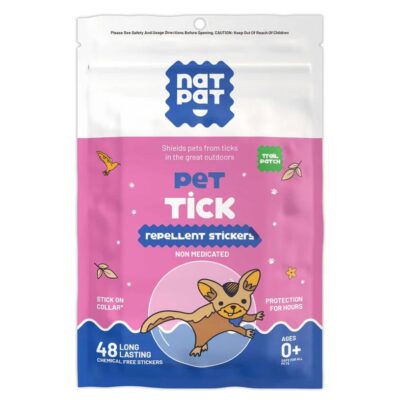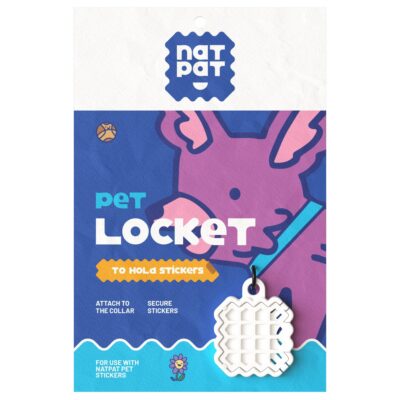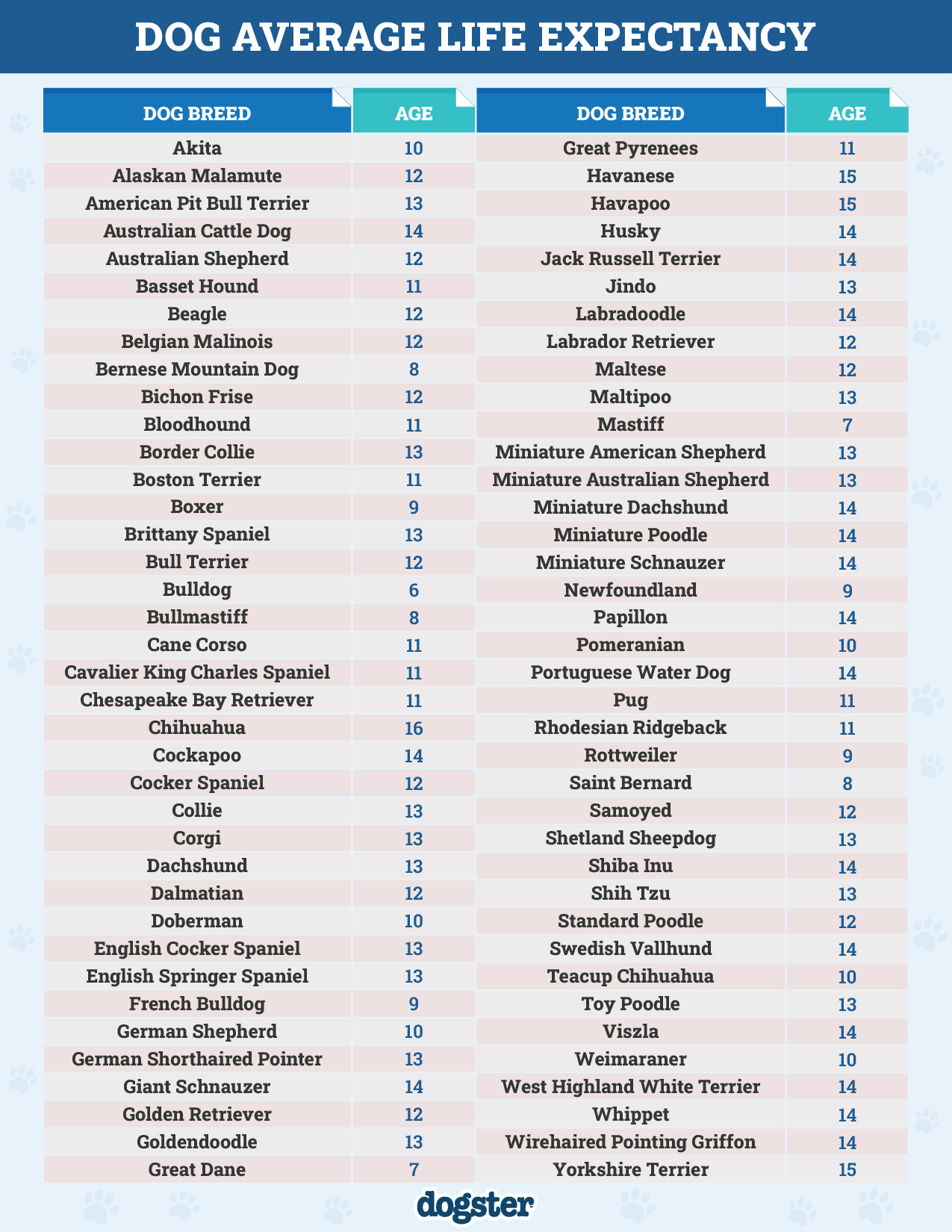Click to Skip Ahead
We give NATPAT an overall rating of 4.7 out of 5 stars.
I don’t know about your pet, but my dog absolutely loathes anything to do with sprays, gels, wipes, and more. If it touches her fur, she hates it. So, when she needs something to help her keep calm or prevent ticks during our mountain hikes… we tend to get into a little scuffle.
Then NATPAT came across my radar, and our unpleasant routine changed for the better with the help of stickers.
Yup, stickers! NATPAT devised a unique and simple way to deliver calming essential oils and tick preventative scents in the form of a sticker you slap onto your pet’s collar. It has cute designs to make us pet people happy and a non-oily-fur solution for pups like mine to keep her happy. But with this brilliant idea comes the most critical question: Do these stickers work?

At a Glance: What We Received
| Rating | Image | Product | Details | |
|---|---|---|---|---|
 | Pet Zen Vapor Stickers | Easy-to-apply sticker Scientifically proven to work Essential oils to calm your pet | CHECK PRICE | |
 | Pet Tick Repellent Stickers | Pet locket on the collar Sticker instead of a spray Non-medicated with no side effects | CHECK PRICE | |
 | Pet Locket | Easily attaches to collars Holds the NATPAT stickers Lightweight and unobtrusive | CHECK PRICE |

About NATPAT

When it comes to pets and children (where NATPAT started), delivering pills or cream medications can be difficult. This rings especially true for children who may have texture sensitivities or pets who have anxious or fearful responses to medication. NATPAT is a company that wanted to find a solution to these issues and discovered it as a cute little sticker out of the founder’s homes. Since then, NATPAT has expanded to worldwide distribution, helping people and their pets globally.
These stickers are infused with natural remedies, releasing essential oils while worn. The company expresses that this is a great first step before jumping into a medicated option for a variety of issues such as anxiety, allergies, bug prevention, sleep aids, and more. But unlike other holistic companies, NATPAT has scientific backing for the efficacy of the ingredients used within those cute stickers, partnering with veterinarians, aromatherapists, pediatricians, and bug experts.
Who Makes NATPAT and Where is it Produced?
NATPAT’s cofounders are Michael Jankie, Gary Tramer, and Andrei Safonau. NATPAT is from Mornington Peninsula in Victoria, Australia, but ships worldwide. Although NATPAT started as patches for children, they have begun adding patches for our four-legged best friends as well with calming patches, tick prevention, and training aids.
Which Types of Pets Is NATPAT Best Suited For?
Any dog or cat, regardless of size or age, can benefit from NATPAT. The patches are just oil releases, so there is no risk for side effects except if your pet is allergic to any of the essential oils (which is uncommon). The Pet Zen Vapor Stickers are excellent for pets who suffer from anxiety or separation issues or need a calming aid for an overstimulated mind. The Pet Tick Repellent Stickers are good for outdoor adventurers who find themselves where ticks are prevalent.

Key Features

The fact that NATPAT uses stickers is already a cool feature, but these products have even more in store than just that.
Price
NATPAT offerings are priced very well, especially for the amount of product you receive for the cost.
- 1 pack | 24 stickers = $19
- 2 packs | 48 stickers = $27
- 3 packs | 72 stickers = $36
- 4 packs | 96 stickers = $42
- 1 pack | 48 stickers = $19
- 2 packs | 96 stickers = $27
- 3 packs | 144 stickers = $36
- 4 packs | 192 stickers = $42
If you subscribe, you get an additional 15% off. Bundle discounts are also available.
The Pet Locket (which holds the stickers on your pet’s collar) is $9.99.
Shipping is always free, with a money-back guarantee if you aren’t satisfied with your stickers.
Ingredients
- Fractionated coconut oil
- Vanilla extract
- Lavender essential oil
- Orange essential oil
- Clary sage essential oil
- Geranium essential oil
- Xiang Mao essential oil
- Patchouli essential oil
- Fractionated coconut oil
- Cedarwood essential oil
- Vetiver essential oil
- Geranium essential oil
- Vanilla Extract
What To Expect
The package is beautifully designed, with quirky cartoon pets adorning the mailing sleeve and the product packages themselves. Both sticker sets come in easy-to-tear bags with a ziploc-style seal to keep the unused stickers safe from the elements.
The stickers themselves are arguably the cutest part, with each one featuring a funny cartoon. This feels like something that carried over from the children’s products, but I greatly appreciated it.
The Pet Locket is precisely as it sounds: just a sticker holder on a ring that attaches to your pet’s collar. The holder is designed in the same shape as the sticker, and all you have to do is open it up and put the sticker inside.

How It Works
To use NATPAT, all you have to do is place the sticker. The sticker can be attached directly to a collar or harness or into the Pet Locket designed to hold it on a collar ring. NATPAT uses its own patented AromaWeave technology to slowly release the oils throughout the use of the product. Each sticker is made of biodegradable bamboo fibers blended with the essential oil concoction.
technology to slowly release the oils throughout the use of the product. Each sticker is made of biodegradable bamboo fibers blended with the essential oil concoction.
The Zen stickers work when placed near your pet’s face (such as the locket that goes on your pet’s collar) to engage with the olfactory receptors in the nose. The scent molecules from the sticker are detected, which then sends signals to the limbic system (the part of the brain responsible for behavior and emotion) to encourage relaxation and tone down anxiety response.
The Tick Repellent stickers are designed to mask your dog to discourage ticks from latching on. The essential oil mix in the stickers interferes with a tick’s chemoreceptors, which are responsible for detecting hosts. The strong scent then overwhelms the tick’s Haller’s organ which detects heat, carbon dioxide, and body odors. The tick is no longer able to sense your pet and cannot figure out where to latch on – like an invisibility cloak for your dog.
Efficacy
The Pet Zen Vapor Stickers are best placed closer to their face (such as using the Pet Locket on the collar), and only one is needed, regardless of pet size. Dogs and cats responding well to essential oils will significantly improve with these stickers, but this is not guaranteed as not all animals are affected. It is also important to note that a holistic approach may not be the right one for animals that suffer from severe behavioral disorders and anxieties, for which medication is more appropriate. Talking to your veterinarian about the best solution for your pet is always encouraged.
The Pet Tick Repellent Stickers uses a similar method to discourage ticks from latching on to your dog. That being said, larger dogs will need more patches than smaller ones to cover their entire body against ticks, so it is best to place multiple stickers on a harness rather than just in a locket on the collar. According to NATPAT, Small dogs are typically okay with just one sticker used, while larger dogs need two, and giant dogs (such as Great Danes or Irish Wolfhounds) may need more.

Scientific Backing
Although names are not directly mentioned by NATPAT, both the Pet Zen Vapor Stickers and Pet Tick Repellent Stickers were formulated by a certified veterinarian and expert in essential oil use for animals as well as various bioactive compounds specialists.
Each of the individual components used in both NATPAT pet products is supported by existing scientific research.
For the Pet Zen Vapor Stickers, the lavender oil ingredient has been proven to reduce stress-related behaviors in domestic pets. There is currently a published study on lavender oil used in household cats. The orange essential oil contains a compound called limonene, which has been studied for its anti-anxiety effects. Geranium has antimicrobial effects, and clary sage contains linalyl acetate, which has been studied for its sedative effects.
Geranium has been heavily studied for its insect-repellent effect in the Pet Tick Repellent Stickers. Cedarwood and vetiver are also well-known as insect repellents, and mixing all three together creates a powerful result.
Safety
The risk of an adverse reaction is extremely low because the stickers do not have direct contact with skin and would be challenging to ingest. The natural products do not tend to pose side effects except if your pet is allergic to any of the oils, which is considered unlikely.
The amount of each oil in the formula for the stickers keeps the exposure minimal and is used in concentrations far below known toxicity thresholds for dogs and cats. The oils are also diluted with ingredients such as fractionated coconut oil, which is used as carrier oil.

Our Reviews of the Products We Received
1. Pet Zen Vapor Stickers

This set of stickers releases calming aromas to soothe your pet, intended for about 8 hours of calming. The package opens to a sheet of stickers, and just one is used per pet. Each sticker has an adorable little critter drawn on it, making this a rather fun experience! Just stick it into the Pet Locket or on your pet’s collar and the sticker will release the oils slowly throughout the day.
- Natural and safe ingredients
- Uses essential oils
- Easy to use
- Intended to last all day
- Eco-friendly design
- Scientifically proven to work
- Adorable designs
- Not all pets respond to it
2. Pet Tick Repellent Stickers

Similar to the Pet Zen Vapor Stickers, the Pet Tick Repellent Stickers work the same way. Also adorned with cute designs per sticker, this one you place when you are heading to the great outdoors with your pup. The stickers release a scent that messes with the tick’s ability to find and latch on to a host, so your pup is essentially “invisible” to them. The use time is 8 hours, and the sticker is strong enough to withstand outdoor romps.
- Alternative to toxic tick repellents
- Natural and safe ingredients
- Just stick and go, no sprays
- Smells pleasant
- Vet-formulated
- Biodegradable
- Does not kill ticks
- May not be as effective on large dogs
3. Pet Locket

The Pet Locket from NATPAT is specially shaped and designed to use the various pet stickers. It is a small plastic locket that opens up to hold the sticker in place. Being so small and lightweight, it doesn’t interfere with your pet’s daily activities and simply dangles from the loop on the collar. This is a much better way to use the NATPAT stickers than simply sticking them onto the collar or harness because the sticker cannot be ripped off on accident.
- Discreet but stylish
- Lightweight
- Unnoticeable to your pet
- Attaches right to the collar ring
- A bit difficult to open with longer nails

Our Experience With NATPAT

My (and my dog Lorelei’s) experience with NATPAT was a piece of cake. Lorelei is a 10lb mixed breed dog, so size-wise, she’s probably ideal for the NATPAT sticker products.
The package came in a specially designed shipping sleeve that I already thought was absolutely adorable. Everything is very well curated and branded, including the actual product bags inside. The stickers themselves had sweet drawings on them, and as someone who is very visual, I really appreciated this extra effort. The package included calming stickers, tick repellents, and a pet locket.
The locket is a clever design, shaped perfectly for the stickers, and weighs next to nothing! It’s easy to use, just open the locket up and place a sticker inside. I do have longer nails, though, so I did find that it wasn’t as easy to open the locket as I had expected, but it likely would have been simpler if my nails were a shorter length.
I used to have to spray this oil-based concoction when taking my dog outside, and she absolutely hated the experience (and I did too because it required fussing with my dog). You probably wouldn’t expect ticks in Southern California, but they absolutely exist – especially after the recent rain this past weekend that create a moist environment that is perfect for them. All I had to do was place a sticker in the locket, put the locket on her harness, and off we went on an adventure. We came back with no ticks!
As for the Zen stickers, we’ve been dealing with some construction happening outside, and the drilling has been rather loud. This is just an annoyance for me, but it has been really bothering Lorelei – she’s gotten anxious and scared by the abrupt, loud sounds. The construction begins around 8 am each day, and that’s when I would plop a sticker on my pup – and lo and behold, she displayed far fewer stress signals than she had before.
10/10, would recommend it for the ease of use and efficacy on my baby!
What Our Vet Says
When you’re dealing with ticks and trying to prevent tick-borne diseases, it’s important to keep in mind that natural and homeopathic products can’t kill ticks and be safe for use on pets. Although the NATPAT Tick Repellent Stickers may discourage ticks from choosing to live on your pets, they can’t provide the same protection as commercial products specifically formulated to kill ticks. If your pet is not regularly exposed to ticks, natural tick repellents may be a good option. However, if you live in a tick-heavy area, especially one with a higher risk of tick paralysis or infectious diseases like Lyme Disease, Rocky Mountain Spotted Fever, or Ehrlichiosis, you will need to use a stronger product.

Conclusion
I really don’t think it gets any easier than NATPAT – a sticker you add to a collar? Sign me up! No fussing with a pet who doesn’t want to be covered in a spray or take a medication. I found that the stickers and little pet locket holder worked so well for my dog, and I’ll be ordering more in the future.
The post NATPAT Pet Zen & Tick Sticker Review: How They’ve Kept My Dog Stress & Pest Free appeared first on PangoVet.





































